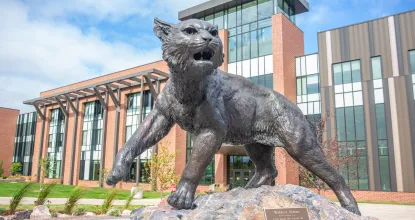

Welcome to our family.
The world of communications and media is moving fast and changing all the time. The disciplines represented in the Communication and Media Studies (CAMS) Department share a focus upon understanding how messages are used to manage relationships with others in contexts ranging from "one-to-one" to "one-to-many" using personal, public and mass-mediated channels of communication. Our state of the art studios, labs and faculty have the knowledge and experience to prepare students for today’s toughest communication challenges and are here to engage and challenge students with every interaction.
Although the goals for different majors may flow from specific arenas and methods of social interaction or performance, graduates of CAMS programs share a fundamental appreciation for what it means to live in a symbolic world, to engage in life-long learning, and acquire a suite of skills that can be transferred to a wide array of careers related to analytical research to health and environmental communication to intercultural (social), interpersonal and/or organizational relationships. To sum it up, students majoring in CAMS learn to critically examine the role communication plays in daily life. They learn to embrace the multicultural foundations for human discourse, to work in teams as well as independently regarding the application of communication concepts to practical situations, and to use what they have learned in the practice of civic engagement.
Our History
The Communication and Media Studies Department (formerly known as the Communication and Performance Studies Department) had its origins in 1906, when Northern offered a course titled "Expression." Eulie Gay Rushmore aimed to teach students to "develop mind, voice and body, and to rouse the students to a consciousness of themselves and to bring them into confidence and power." Ms. Rushmore retired in 1925. In earlier years, speech was part of the English and Expression Department. In 1958, the Speech Department separated from English. General and public speaking, interpretive reading, radio and television, speech science and correction, and theatre were the different disciplines in the department. Forest Roberts headed the department until 1966 and played an important role in its continuing development.
James Rapport, who succeeded Forest Roberts as department head in 1966, was instrumental in increasing the prominence of the Speech Department. The ground breaking for the Fine and Practical Arts Building and the Little Theatre, which Rapport helped design, was held in 1962. Before this theatre was built, productions were held in the Kaye Hall auditorium, where acoustics were poor. In 1969, the Little Theatre was renamed in honor of Forest Roberts.
In 1973, the department split with Speech Science and Correction becoming the Communication Disorders Department, while the other areas of study remained in the Speech Department. During the 1970s, bachelor's degrees were offered in broadcasting, mass communication, general speech, speech communication, speech education and theatre. By the early 1990s, the department had stopped offering degrees in general speech and speech education but had added a major in public relations.
The department’s name was changed by board action in 1992 to Communication and Performance Studies, or CAPS, and Donald Rybacki succeeded James Rapport as department head in 1993. In 1995, the Forest Roberts Theatre’s production of CAPS faculty member Shelley Russell’s original musical “Haywire” was honored by the American College Theatre Festival by being invited to perform at the Kennedy Center in Washington, D.C. By 2000, the broadcasting and mass communication curricula had been reorganized into two tracks: electronic journalism and media production and new technology. In 2004, the department launched a new major in entertainment and sports promotion. In 2008, the speech communication major was revised to become communication studies and James Cantrill succeeded Donald Rybacki as department head in 2008.
In 2019 the NMU Board of Trustees approved yet another change - a restructuring plan for Academic Affairs that created four divisions within the College of Arts and Sciences. The Division of Visual and Performing Arts - composed of a new combined school of Music, Theatre and Dance, along with the established School of Art and Design. The Division of Social Sciences including the following disciplines: economics, communications, broadcasting and journalism (now called the Communication and Media Studies Department or CAMS); political science; and sociology and anthropology.
Although these changes do bring about new opportunities and visibility for all, they also change the former make up of the CAMS department and take it from five majors and seven minors down to three majors and four minors. The Public Relations major and minor moved to the College of Business and the Theatre and Entertainment Arts major and minor, along with the Dance minor, moved to the new department of Theatre and Dance, which is now led by Bill Digneit, Department Head and Director of the Forest Roberts Theatre.
Department Heads: Forest Roberts, 1958-66; James Rapport, 1966-93; Donald Rybacki, 1993-2008; James Cantrill, 2008-present
Source: A Sense of Time, Russell Magnaghi, pp. 93-94, with additional information provided by Donald Rybacki and James Cantrill.